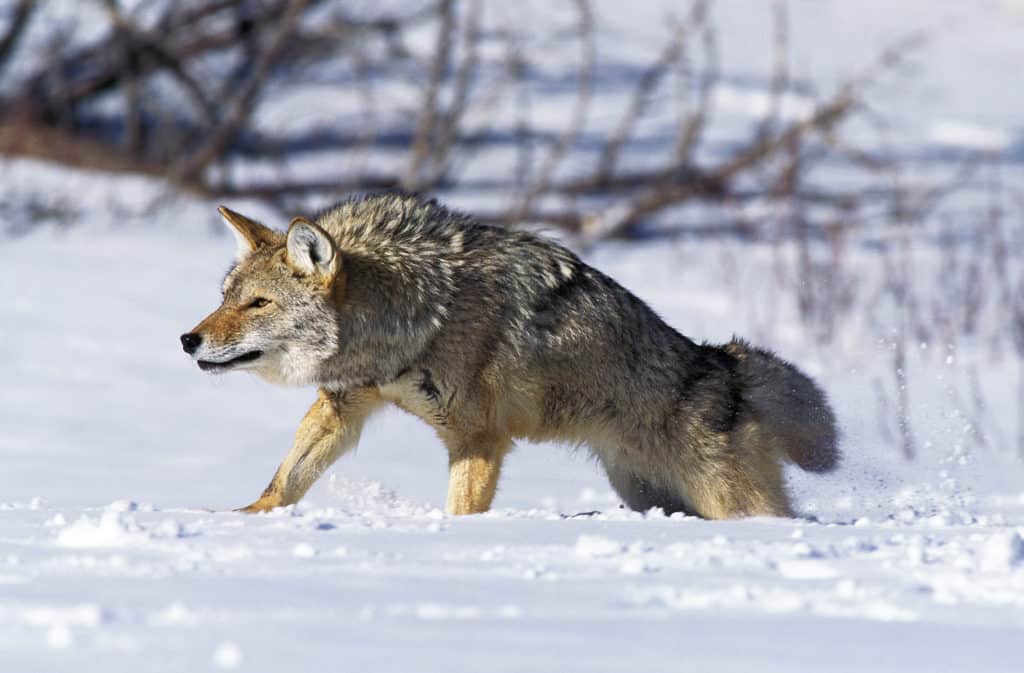The absolute best time for coyote hunting? On a very cold night, a few days after a heavy snowfall.
Heavy snow means hungry coyotes.
Imagine your appetite after a week of sitting in a cabin buried under three feet of snow. Suddenly, a plow clears the road outside, and you can finally make your escape. How long before you’re jumping in your truck to scarf down a gas station hot dog that’s been sitting on a fly treadmill for two days?
Coyote hunting after a heavy snowfall is wickedly profitable, but you will have to wait. Coyotes are intelligent animals. They will hunker down and conserve their energy. They won’t be interested in fruitless searching for mice and voles under much more than a foot of snow. They won’t burn valuable calories cutting a trail to nowhere. They will wait. They will wait till their road is clear. Their coat keeps them warm and protected from the elements.
Wait until there is a hardtop, then start coyote hunting.
Generally speaking, coyotes will begin to move again as soon as the snowpack supports most of their weight. Now, they will freely travel the greater distances needed to find their prey animals.
How and when the snow gets hard enough for a coyote to walk on is primarily determined by three factors: wind, rain, and sunlight.
Wind packs snow into a hard layer by blowing it over and against obstacles, breaking it into smaller and smaller pieces that eventually settle into tight, dense slabs. While the faster the wind blows, the stronger the crust becomes, generally winds from 20 to 60 mph produce the best effect.
Rain that falls and freezes on top of an existing snowfall. Generally the weaker, and certainly the slipperier, of the three types of crust.
Sunlight during the day causes melting and wetting of the existing snow and can form a very hard layer.
Why coyotes enjoy a road over deep snow
If there’s one thing a coyote enjoys, it’s a venison steak. And when the ground is buried under a foot or more of snow, and the rabbits, voles, and squirrels have disappeared, the deer are all that’s left.
Fortunately for the coyotes, and the coyote hunter, crusted snow that will bear the full weight of a running adult coyote will drastically reduce the speed and maneuverability of an adult whitetail. https://emammal.si.edu/okaloosa-science-home-page/blog/do-coyotes-cause-deer-declines
Scientists that study coyote stomach contents are always wondering why there always deer meat in their bellies. As a result, they often point out that perhaps the coyotes are simply scavenging roadkill rather than enjoying great success due to the weather. Maybe, but as every deer hunter knows, nothing is more visible than a 300 lbs man in hunter orange standing in a snow-filled field, except for a moving buck.

Make sure you keep your rifle out of the snow by using a reliable tripod. I use the Bog DeathGrip. If you use this link I will receive a small commission—at no additional charge to you.
Act like a deer while coyote hunting in deep snow.
Oh, I’ll admit, crusty snow is CRUNCHY snow. Yes, you can make a lot of noise and be heard a mile away on a quiet day. But does this always lead to coyotes immedietly departing the area?
If you find the same crust that helps the coyotes get around is potentially giving away your presence, try sounding like a deer as you move. Take a few slow steps, stop, and wait. Walking this way at least attempts to mimic the sounds a coyote might hear from a nearby deer.
The best spot for coyote hunting during the best time?
If you have safe access to a snowmobile trail, put your stand on it. Find a nice (again, safe) spot to snuggle into the tree line and conceal yourself, and then get the caller into action. If you cant get a mile away from roads and homes, you’ll be sitting on a gold mine. Coyotes hearing a deer distress call will use that trail days before the hardtop forms on the snow.
You could also make your own trail. You can create a snowmobile trail of your own, make one with your ATV (my go-to method every year), or cut one with snowshoes. Trust me; those lazy coyotes will be leaving paw prints in your trail within hours some nights. A field of smaller than five acres, surrounded by trees, can be just the perfect size. Start at the road and make a maze that comes as close as possible to any visible vegetation sticking up out of the snow. That little bit of greenery will be precisely where a coyote will stop and pee while you are aiming.
Perfect time + Perfect place = Perfect Stand
Now, all you have to wait for are some subzero temps. With all three advantages, you can no go put fur in the back of the truck.

